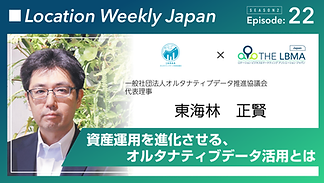
Latest Episode : 2025/12/8 delivery
Data Changes the Future: City Planning Driven by Maps and People Flow Data by Geotechnologies
Geotechnologies' people flow data, collected primarily through the point-earning service "Trima," is continuous, highly accurate, and contains human attributes. When combined with maps, primarily "MapFan," it enables a variety of urban development projects. In this session, we will hear about how this data can be used to develop cities and the future, citing specific examples.
This seminar is an archived version of the Location Information Seminar held at Kindai University in July 2025.
Speaker:Akifumi IshizuGeosolutions Sales Division, Sales HeadquartersDeputy General Manager, Enterprise/Public Business
Season 3: Archived Episodes:
Season 2: Archived Episodes:
Location Weekly Japan is a podcast run by LBMA Japan (Location Business & Marketing Japan), a general incorporated association that promotes business marketing services using location data. Every week, we interview management and business personnel from member companies, introduce the latest examples of location data usage, and share notable events around the world, as well as behind-the-scenes stories that can only be heard here.
As we are an organization with many IT-related members, you will hear a lot of foreign words, but in this podcast we will introduce examples of how location data is being used in a way that is as easy to understand as possible, so please feel free to listen.
MC: Kuniyuki Kawashima (Representative Director of LBMA Japan)
Updated every Monday.











.png)









.png)










































.png)

































